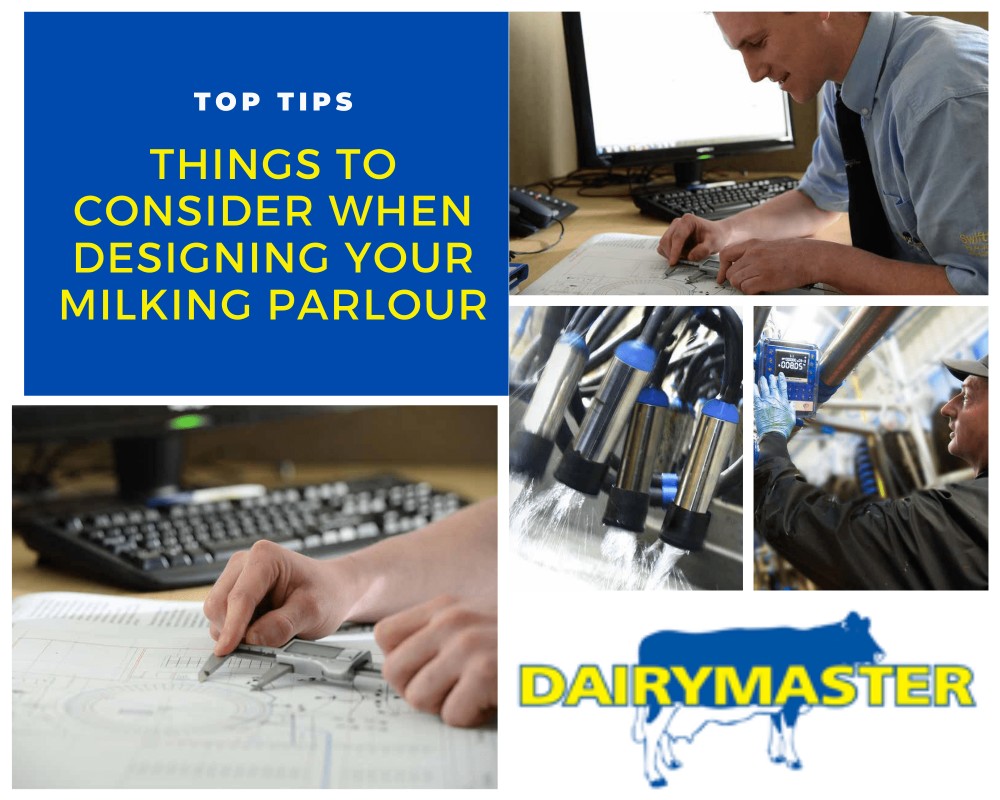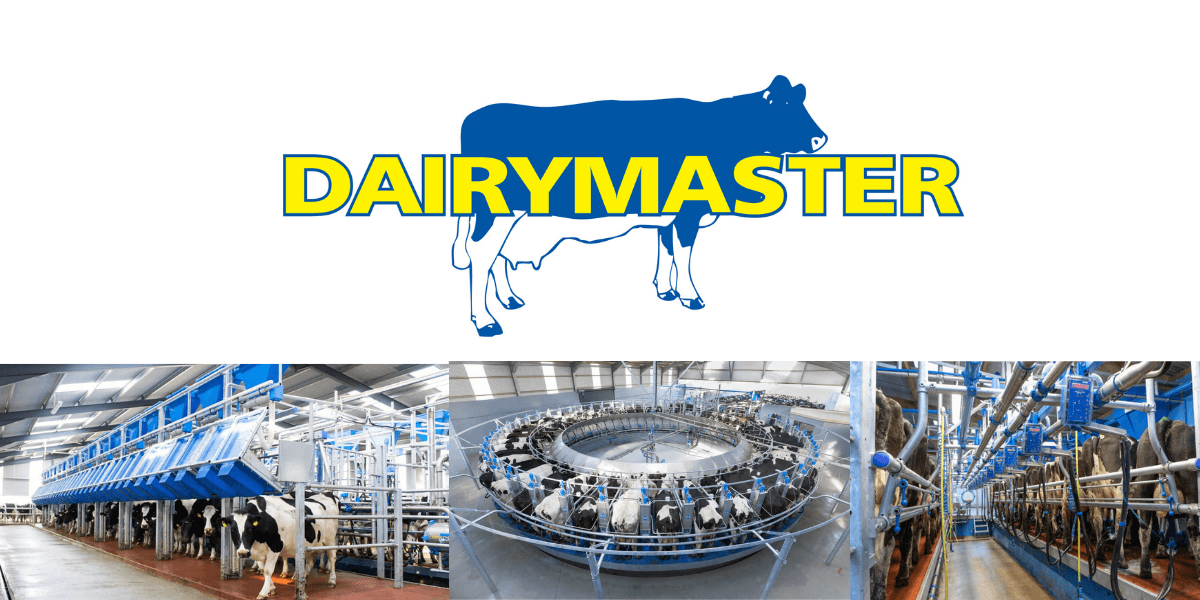
Dairymaster takes us through the top tips of things to consider when designing your milking parlour.
1. KNOW WHAT TYPE OF PARLOUR SUITS YOUR NEEDS
Finding out what type of parlour suits your needs is usually the first step in the design process. If you love to milk choose a system that is operator controlled. Research has shown modern operator-controlled systems (OCS) perform better than automated milking systems (AMS). They require equal to less labour compared to an AMS and the revenue using an OCS is generally much higher. When equipped with the latest technology and the option of various levels of automation traditional milking has become the new milking standard. Currently, there are two popular OCS’s available. They are herringbones, with either swingover or double-up option and rotaries. The aim of milking facilities in certain parts of the world is to have all cows milked and the parlour cleaned within 1.5 hours, after this time the operator’s concentration levels decrease. You can increase throughput in the parlour by increasing the number of units or by adding personnel. Choosing a milking parlour that milks out faster will also give you extra efficiency and more enjoyment.
HERRINGBONE
A herringbone is still by far the most popular parlour choice across the world. They are budget friendly, compact and can often be retrofitted into existing buildings. Cows can be milked either side by side or standing at an angle towards the operator and the operator moves up and down the pit during the milking process.
DOUBLE-UP
A double-up parlour gives you maximum performance in a small space. This system is suited where space is an issue and you want to use your existing shed. A shorter parlour also means less walking up and down the milking pit for the operator and faster row changes. Milk controller units are closer to the operator which makes for easier access the number of units. This means that an eight-unit double up effectively has sixteen milking units resulting in higher installation cost. Cluster on capacity approaches 60% when working efficiently
SWINGOVER
If efficiency is your priority when milking, choose a system with swingover arms. With this system you milk two cows per unit. When cows on the left side of the parlour are milking you can prep cows on the right side. When milking is finished for cows on the left you swing the cluster to the right and start attaching. When working efficiently you can milk up to nine animals per hour - a cluster on capacity of nearly 90%. The swingover arm will hold the cluster making milking less labour intensive and faster.
ROTARY
If your herd size is approaching 200 cows it is time to start thinking about a rotary parlour. The biggest advantage of a rotary is that you can keep milking, the operator stays in the one position and the cows come to you. There is no stopping to allow a new row of cows to enter. In other words, cow throughput is exceptionally good. There are basic entry level options to high tech options available to suit each farmer’s needs and wants.

2.THINK ABOUT THE FUTURE…
When thinking about buying a parlour, you must consider what your herd is going to look like in ten years’ time. Are you going to expand your herd? Are there any land restrictions to the number of cows you can keep in the future? Most farmers replace their parlour every 15 to 30 years. In the current climate with herds expanding rapidly it is necessary to take this into account during the design process. Things to consider are whether to install a larger parlour or to build a larger building where you have the option of adding on extra units in future years.
3. DESIGNING FOR THE COW
The best way to design a good working parlour is to prioritise good cow flow to and from the parlour. Optimal cow flow can be established by creating a smart layout. Cows do not like sharp bends, level differences, slippery floors or protruding objects. Angles should be greater than 90° and the entire layout should have a minimum amount of turns. If turns are necessary make sure to have plenty space for long radius bends. The size of the waiting area or collection yard is dependent on herd size and parlour type. Installing an automatic backing gate will enable operators to work without delay and allows stress-free cow flow. Also ensure that the design of your facilities is tailored to your cows’ size as it is very frustrating to find out after installing
the parlour that animals are restless due to lack of space or that you must bend over too much for a simple attachment of clusters. Cows exiting the parlour can do so by means of a rapid exit system which further speeds up milking time.
4. DESIGNING FOR THE OPERATOR
If you spend on average 1.5 hours per milking and are milking twice daily you are working almost 1,100 hours in your parlour each year or to break it down further 21 hours per week. With herd size increasing, more is required from you both physically and mentally and comfort in the parlour becomes paramount. Milking comfort can be achieved by designing milking equipment ergonomically. This means that the platform and all other necessities are made to your requirements and size. When working with personnel all equipment should be customisable. Think about a moveable floor and controller units at the right height. The parlour pit and other working areas should be well ventilated, but not draughty and it must be well lit. A minimum of 250 lux for the milking area is required and 500 lux for the pit. Aim to use as much natural light and ventilation as possible to cut down on costs, for example, think about installing large roller doors on both sides of a rotary parlour.
5. LAYOUT OF BUILDINGS AND SITES
The next step in the process is to get your parlour designed according to your site’s requirements. There is a whole lot more to designing a parlour than you would initially think. Are you planning to build in an existing building or do you have a greenfield site? A greenfield site is often a lot easier to design than trying to fit a new parlour in an existing building. There are many variables to be considered especially when designing for an existing building.
First; power supply, is there enough power available to feed all the automation features you would like to have in your parlour? If not, can it be converted or would that be too costly of a venture and would you be better off to simplify the design?
What about air flow? Adding extra buildings could severely reduce natural ventilation in your existing buildings driving up construction prices. During the design process the best position of the parlour should also be considered. Think about placing to the prevailing wind direction to ensure maximum ventilation. A parlour should be dry within 1.5 hours after cleaning. A damp environment invites micro-organisms increasing lung and mastitis cases on farm. It also causes the operators to work in a damp and often smelly environment. Dry fresh air is beneficial for job satisfaction and will keep your workers healthier at the same time.
Fall of the parlour is another thing, a milking parlour should always fall towards the receiver side. When building on a slope this could prove difficult since the fall is often opposite from the best area to access the parlour. Careful thought needs to be given towards accessibility for milk and feed trucks especially when building on a greenfield site. The milk truck driver should be able to access the milk tank without making too many manoeuvres and the milk tank area should be closed off from the parlour and other rooms. A hygiene area where the truck driver can wash hands should be provided to safeguard biosecurity.
When including in parlour feeding you should not forget there needs to be space and easy access for the feed bin/silo.
Finally, buildings directly associated with the parlour also belong to the design. What is the best position for the milk tank? Where will the machine plant be situated? When working with personnel toilet and shower facilities should be in place as well as a canteen/living area and an area to change one’s clothes. Easy access and simple layout are always preferable options. Tiling the area top to bottom will ensure longevity and top hygiene status of your buildings.
6. WHAT LEVEL OF AUTOMATION?
Automation is where technology come into play. There are different levels of automation. The most basic should include automated cluster removal (ACR’s) and automatic cow identification to optimise work efficiency for the operator. Another great tool is the use of an automated backing gate. It saves the operator hopping in and out of the pit simplifying the milking process while optimising cow flow. A backing gate is almost always incorporated in the design for a rotary. Make sure that the collection area is well sized for your herd or else you should consider grouping cows. Leaving that extra bit of space for the cows, will guarantee them entering the parlour or the platform swiftly while being relaxed. At the higher spec of automation, you should be thinking about voice assist, automated teat spraying & cluster flushing systems & ultimately fully integrated advanced milking controller units. These units combine information from several different systems on the farm such as the milk cooling tank, heat detection system and milk quality reports & display this information right at the milking point where you need it.
7. ALWAYS GO FOR THE ENERGY EFFICIENT OPTION
Even though it is a higher investment upfront, energy saving options to your parlour are worth seriously considering. Return on investment is usually within a short period of time (up to 5 years) after that you are making money. Think about investing in heat recovery technologies for warming up water while cooling the milk. Or invest in a super insulated milk cooling tank to slash your cooling costs. A variable speed vacuum pump in the milking parlour will control vacuum levels during milking saving you money in electricity and ultimately reducing wear and
tear of your equipment.
Dairymaster use Science and Technology to make dairy farming more profitable, enjoyable and sustainable.
Browse the Dairymaster range, compare which system suits your farm and we'll connect you with their Product Specialist.


